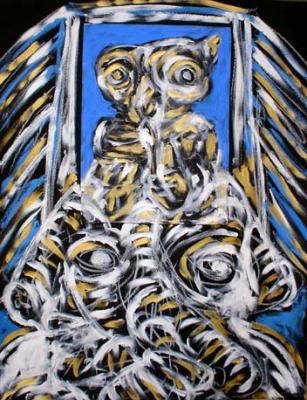J Castilla-Bambaren
J CASTILLA-BAMBAREN "THE SIMBOLIC WEAVING"
"THE SIMBOLIC WEAVING"
In a creative path that was difficult to predict because, since his early beginning in 1980, this artist has been one of the most given to absorb elements of diverse artistic languages, assimilating them as alternative and simultaneous registers of one sensibility -his own-.
The latest paintings of Castilla-Bambaren evidence a depuration in a way of radical revision.
Until 1990, the synthesis of elements that characterized his paintings seemed ruled principally by the expressionistic spirit, because of the significative deformation of the beings that populated his works, and the evidently nervous application of the pictorial material and even in the chromatic tones clearly chosen for his creation of atmospheres. Apparently this expressionistic animation, sustained scenes of a narration with a plot impossible to decipher, that increased the sense of uneasiness in the observer. Later, the artist will discover that without abandoning the visual emblems developed in the process, he could simplify them until their transformation into concrete signs, even in a nature nearer to a recurrent motif, the serial pattern.
With these new simplicity CastiIIa -Bambaren opened different possibilities of condensation and expansion of his symbolic language. The effort of suggesting symbols instead of representing beings-characters in specific situations as an answer to narrative urge, opened him to the possibility that every canvas could be an integral symbol of painting, painting as an act of conceptual creation-in relation with life.
In that way his artistic proposal was reconfigured in the essential terms of his vision as a painter, in which violence -as a sign of human behavior - has a preponderant place.
Without leaving the acrylic as a medium of creation Castilla-Bambaren reaffirms the planimetric character of his pictorial work.
The vigorous impasto in the canvas, is now selectively applicated in areas alterning them with technical treatments so different: as the tingeing and dyeing of the canvas with diluted pigments, or the rubbed brushwork made with a used brush, or the incision. In certain cases, Castilla-Bambaren applies canvas fragments of different qualities and, creates textures in the surface generating in this way a great variety of stimulus, that construct an ambit of tactile sensations that are, at the same time, a new dimension of significance. It is possible that mostly all the narrative has been put aside. but the signs retain a clear fictitious profile that enchains and produces a total symbolic-visual structure, that would act as a transposition of the structure of the myth to the space of the pictorial creation, as an essential weaving of the sensibility of the artist.
The representations of signs like the skull, suggesting the notion death in life
and other suggestive forms of animal bodies or vegetal structures get in that way, the nature of a pictorial imperative over all others. The presence is coherent not by voluntarism, like the one that could be behind the will to make narrative in painting ,but as a concerted approach that Castilla-Bambaren proposes in each canvas.
The visual coherence of the whole is what convinces the observer that the ambiguous burden of existential roots in the painting has resonances that can be tracked to the nucleus of representation, contained in each sign.
The representation is often accompanied by divisions of the visual camp, that insinuates a possible symmetry -and by that way an order - that finally is not real. Certain pseudosymmetry resemble structures of popular religiosity like "the cross of the roads "(*) and their symbols of the passion. The division of camp allows a risky handle of color, maybe not too much in the violent contrast but in exploiting the vibration by the superimposition of layers, that always reveal the subjacent color around the elements surrounding them, like auras.
Its because of this, that the recent paintings of Castilla-Bambaren, suggest the conquest of equilibrium in relation with his early work… but the moment of apparent calm continues being unstable and even insinuates danger.
The artist handles color in function of its power to alert sensibility, (a remnant of recontextualized expressionism), the simplification of forms and the interconnection of them in the painted surface. (Just even because one does echoes of the others), suggest even with more strength the nudity of a man enfrenting the materialization of the myths of the specie...
JorgeVillacorta curator
Lima /Peru 1994
(*) " la cruz del camino "


